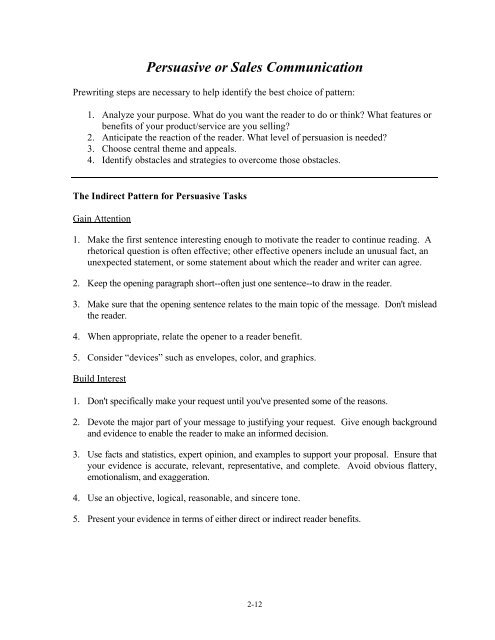Ohio University College of Business Communication Standards
Ohio University College of Business Communication Standards
Ohio University College of Business Communication Standards
You also want an ePaper? Increase the reach of your titles
YUMPU automatically turns print PDFs into web optimized ePapers that Google loves.
Persuasive or Sales <strong>Communication</strong><br />
Prewriting steps are necessary to help identify the best choice <strong>of</strong> pattern:<br />
1. Analyze your purpose. What do you want the reader to do or think? What features or<br />
benefits <strong>of</strong> your product/service are you selling?<br />
2. Anticipate the reaction <strong>of</strong> the reader. What level <strong>of</strong> persuasion is needed?<br />
3. Choose central theme and appeals.<br />
4. Identify obstacles and strategies to overcome those obstacles.<br />
The Indirect Pattern for Persuasive Tasks<br />
Gain Attention<br />
1. Make the first sentence interesting enough to motivate the reader to continue reading. A<br />
rhetorical question is <strong>of</strong>ten effective; other effective openers include an unusual fact, an<br />
unexpected statement, or some statement about which the reader and writer can agree.<br />
2. Keep the opening paragraph short--<strong>of</strong>ten just one sentence--to draw in the reader.<br />
3. Make sure that the opening sentence relates to the main topic <strong>of</strong> the message. Don't mislead<br />
the reader.<br />
4. When appropriate, relate the opener to a reader benefit.<br />
5. Consider “devices” such as envelopes, color, and graphics.<br />
Build Interest<br />
1. Don't specifically make your request until you've presented some <strong>of</strong> the reasons.<br />
2. Devote the major part <strong>of</strong> your message to justifying your request. Give enough background<br />
and evidence to enable the reader to make an informed decision.<br />
3. Use facts and statistics, expert opinion, and examples to support your proposal. Ensure that<br />
your evidence is accurate, relevant, representative, and complete. Avoid obvious flattery,<br />
emotionalism, and exaggeration.<br />
4. Use an objective, logical, reasonable, and sincere tone.<br />
5. Present your evidence in terms <strong>of</strong> either direct or indirect reader benefits.<br />
2-12




